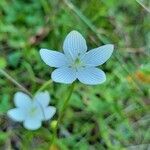Plants 2–4 dm; blades of basal lvs stiff and leathery, ovate to round-ovate, 3–5 × 1.5–4.5 cm, blunt to subacute, at base broadly rounded to subcordate, decurrent on the upper part of the petiole; cauline lf usually present, at or well below the middle, sessile or short-petioled, the blade like the basal ones but smaller; pet sessile, 10–18 mm, with several strong veins, the central 5 usually unbranched; staminodes white, 4–7 mm, a little shorter than the stamens, 3-parted for 3/5 or 4/5 their length; 2n=32. Calcareous bogs, shores, and wet meadows; Nf. and Que. to Sask., s. to N.J., Pa., Ind., Io., and S.D. Aug., Sept. (P. americana; P. caroliniana, misapplied)


